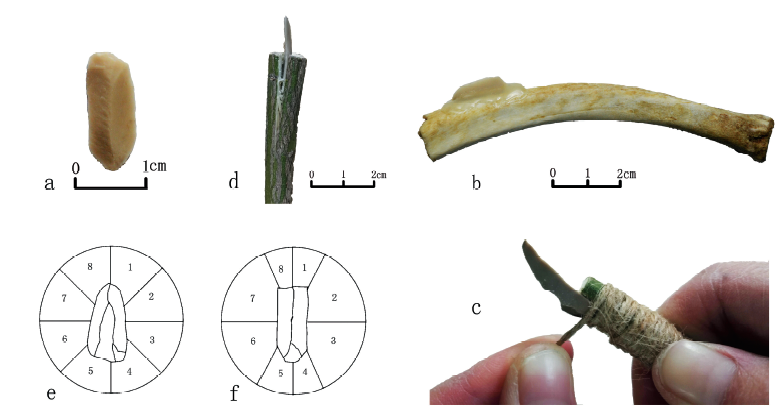

An experimental study of use-wear on dolomite microblades from Shuidonggou
Received date: 2018-12-18
Online published: 2020-07-17
Shuidonggou is an important Late Paleolithic Site complex in North China. The raw materials are mainly local dolomite. In this paper, we conducted 29 groups of microwear experiments with microblades and flakes made of dolomite from the Shuidonggou region. The results indicate that use-wear differs according to the different tool motions and the varied worked materials. It is efficient for microblades to be hafted and employed as composite tools. The lateral edges of hafted microblades are efficient for scraping, cutting and shaving, and the points (distal ends) of microblades are suitbale for low hardness plants and animals. The use-wear produced by the same activities shows varied characteristics on artifacts made of different raw materials. We discussed the appropriate scope of tool motions and worked materials for microblades, and provide reference data for further functional study of microblades unearthed from Shuidonggou site.

Key words: Shuidonggou site; dolomite; microblade; microwear experiment
Guanyue YU , Mingjie YI , Xiaoling ZHANG , Fuyou CHEN . An experimental study of use-wear on dolomite microblades from Shuidonggou[J]. Acta Anthropologica Sinica, 2020 , 39(02) : 193 -207 . DOI: 10.16359/j.cnki.cn11-1963/q.2019.0054
| [1] | 安志敏 . 海拉尔的中石器遗存——兼论细石器的起源和传统[J]. 考古学报, 1978,3:289-316 |
| [2] | Lu LD . The Microblade Tradition in China: Regional Chronnologies and Significance in the Transition to Neolithic[J]. Asian Perspectives, 1998,37(1):84-112 |
| [3] | 甘肃省博物馆文物工作队武威地区文物普查队. 永昌鸳鸯池新石器时代墓地的发掘[J]. 考古, 1974,5:299-308 |
| [4] | 崔天兴, 杨琴, 郁金城 , 等. 北京平谷上宅遗址骨柄石刃刀的微痕分析:来自环境扫描电镜观察的证据[J]. 中国科学:地球科学, 2010,40(6):737-744 |
| [5] | 陈淳 . 东亚与北美细石叶遗存的古环境[J]. 第四纪研究, 1994,4:369-377 |
| [6] | 陈淳 . 几何形细石器和细石叶的打制及用途[J]. 文物季刊, 1993,4:72-78 |
| [7] | 安志敏 . 中国细石器发现一百年[J]. 考古, 2000,5:45-56 |
| [8] | Elston RG, Brantingham PJ. Microlithic Technology in Northern Asia: A Risk-Minimizing Strategy of the Late Palaeolithic and Early Holocene[A]. In: Elston RG, Kuhn SL(ed). Thinking Small: Global Perspectives on Microlithization[C]. Washington D. C.: American Anthropological Association, 2002, 103-116 |
| [9] | Goebel T. The “Microblade Adaption” and Recolonization of Siberia during the Late Upper Pleistocene[A]. In: Elston RG, Kuhn SL eds. Thinking Small: Global Perspectives on Microlithization[C]. Washington DC: American Anthropological Association, 2002, 117-131 |
| [10] | 李占扬, 赵清坡, 鹿又喜隆 , 等. 河南灵井许昌人遗址细石器功能研究[J]. 第四纪研究, 2017,37(4):789-796 |
| [11] | 陈虹 . 华北细石叶工艺的文化适应研究——晋冀地区部分旧石器时代晚期遗址的考古学分析[M]. 杭州: 浙江大学出版社, 2011, 138-147 |
| [12] | 张晓凌 . 石器功能与人类适应行为:虎头梁遗址石制品微痕分析[D]. 北京:中国科学院古脊椎动物与古人类研究所, 2009, 97-101 |
| [13] | 王小庆 . 兴隆洼与赵宝沟遗址出土细石叶的微痕研究[A].见: 西北大学考古学系、西北大学文化遗产与考古学研究中心编.西部考古(第一辑)[C]. 西安: 三秦出版社, 2006, 59-76 |
| [14] | Odell GH . The Role of Stone Bladelets in Middle Woodland Society[J]. American Antiquity. 1994,59(1):102-120 |
| [15] | 宁夏文物考古研究所, 中国科学院古脊椎动物与古人类研究所. 水洞沟: 2003-2007年度考古发掘与研究报告[R]. 北京:科学出版社,2013: 9, 35-36, 73-88, 157-252 |
| [16] | 刘德成, 陈福友, 张晓凌 , 等. 水洞沟12号地点的古环境研究[J]. 人类学学报, 2008,27(4):295-303 |
| [17] | 张乐, 张双权, 徐欣 , 等. 中国更新世末全新世初广谱革命的新视角:水洞沟第12地点的动物考古学研究[J]. 中国科学:地球科学, 2013,43(4):628-633 |
| [18] | 高星, 沈辰 . 石器微痕分析的考古学实验研究[M]. 北京: 科学出版社, 2008 |
| [19] | 崔天兴 . 东胡林遗址石制品研究——旧新石器时代过渡时期的石器工业和人类行为[D]. 北京:北京大学, 2010, 116-132 |
| [20] | 方启 . 吉林省东部地区黑曜岩石器微痕研究[D]. 吉林:吉林大学, 2009, 18-181 |
| [21] | 张佩琪 . 水洞沟第2地点2014-2015年度出土石制品研究[D]. 北京:中国科学院古脊椎动物与古人类研究所, 2017, 45-60 |
| [22] | 宋艳花 . 山西吉县柿子滩遗址石英岩石制品研究[D]. 北京:中国科学院古脊椎动物与古人类研究所, 2011, 57-128 |
| [23] | 黄蕴平 . 沂源上崖洞石制品的研究[J]. 人类学学报, 1994,13(1):1-14 |
| [24] | 杨霞, 陈虹, 王益人 . 角页岩雕刻器的微痕实验研究[J]. 人类学学报, 2018,37(1):41-52 |
| [25] | 顾玉才 . 海城仙人洞遗址出土钻器的实验研究[J]. 人类学学报, 1995,14(3):219-228 |
| [26] | Zhang PQ, Zhang XL, Zwyns N , et al. The contribution of use-wear for stone tool identification at the Upper Paleolithic site Shuidonggou Locality 2, North China[J]. Quaternary International, 2020,535:29-37 |
/
| 〈 |
|
〉 |